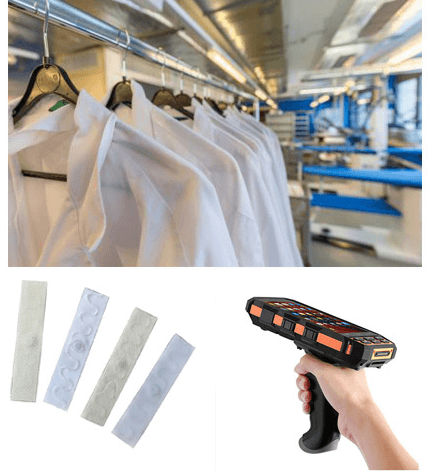UHF RFID Textile Tags For Hotel Linen Tracking
RFID textile tag is suitable for laundry, linen industrial washed application. It can bear 180℃ high temperature ironing and 200 times cycling industrial washing. The performance is stable and reliable.
1.Reduce manual sorting of linen
Hospitals, hotels, linen plants, or any company dealing with several types of textiles all need to sort linen for cleaning. The sorting process usually requires 2-8 people to sort the linen into different chutes, and sorting all the linen can take hours. With the RFID linen management system, RFID textile tag is sewn into each piece of linen. When the RFID textile tag passes through the assembly line, the RFID reader sends an inquiry signal and reads the tag. After all the tags have been read, the system will confirm what type of linen is being read and send the linen to the appropriate place or machine. The system’s processing results will be displayed on the screen, so you can immediately send your linen to the next place.
Enterprises now use RFID textile tags to eliminate manual linen sorting and significantly reduce the labor expenditure on linen sorting. Instead of relying on the human eye to distinguish bar codes or linen, now only need to assign 1-2 people to send the linen to the next procedure methodically.
2. Provide accurate cleaning quantity record
The number of cleaning cycles per piece of linen is an important data, the cleaning cycle analysis system can effectively help predict the life end date of each piece of linen. Most linens can only withstand a certain number of high-intensity cleaning cycles, the linen begins to crack or become damaged after the rated number of times. It is very difficult to predict the end-of-life date of each piece of linen without the number of cleaning records. This also makes it difficult for the hotel to make a subscription plan for replacing the old linen.
When the linen comes out of the washing machine, the RFID reader will detect the RFID tag sewn into the linen. Then, the number of cleaning cycles of the linen will be uploaded to the system database. When the system detects that a piece of linen is nearing its end of life date, the system prompts the user to reorder the linen. This program ensures that the company has the necessary inventory of linen, which greatly reduces the replenishment time due to loss or damage of linen.
3. Provide fast and easy visual inventory management
Lack of visual inventory management can make it difficult for companies to make accurate emergency response plans, achieve efficient operations, or prevent the loss and theft of linen. If a piece of linen is stolen and the company does not implement a daily inventory audit, the company may face potential delays in its daily operations due to inaccurateinventory management.
UHF RFID textile tags sewn into each piece of linen help companies manage daily inventory more quickly and efficiently. RFID readers placed in each warehouse will perform ongoing inventory monitoring to help pinpoint where the linen is lost or stolen. Inventory quantity reading by RFID can also help companies that use outsourced cleaning services. Read the stock quantity before sending the cloth to be washed away, and read the quantity again after the cloth is sent back to ensure that no linen loss during the final washing process.
4. Reduce loss and theft
Nowadays, most companies around the world are still using simple, human-dependent inventory management methods to try to count the number of lost or stolen linen. Unfortunately, there are a lot of mistakes caused by manpower when counting hundreds of pieces of linen. When the statistics are over, the next step is to try to find out the vulnerabilities in the system. Usually, when a piece of cloth is stolen, it is almost impossible for a company to find a thief, and even less likely to get compensation or return.
The unique EPC serial number in the RFID textile tag enables enterprises to identify which piece of linen has been lost or stolen, and to know its final location. If a piece of linen is taken away from a room in a hotel or hospital, guests in that room can be charged with the money to ensure that the business does not suffer losses.
5. Provide meaningful customer information
Companies that rent linen have a unique way to study user behavior by RFID tags on rental linen to understand customers. RFID textile tags sewn into the fabric help record customer information such as historical renters, rental dates, rental duration, etc. Keeping these records helps companies understand product popularity, product history, andcustomer preferences.
6. Achieve precise check-in and check-out system management
The process of renting linen is often very complicated, unless the company can establish a simple concept of saving information such as rental date, expiration date, customer information and so on. And RFID system provides a customer database, not only can store important information, but also can timely remind the enterprise of the expiration date of a piece of linen is approaching and other small matters. This feature allows companies to communicate with customers about approximate return dates and provide them to customers. This effectively enhances customer relationships. It also reduces unnecessary disputes and increased linen rental income.
If you want to know more details, please contact with us, we could give you our best price.
website www.gsrfid.com
Mail: cici@gsrfid.com
Cell/Whatsapp :0086 18202879549
Post time: Sep-27-2019


